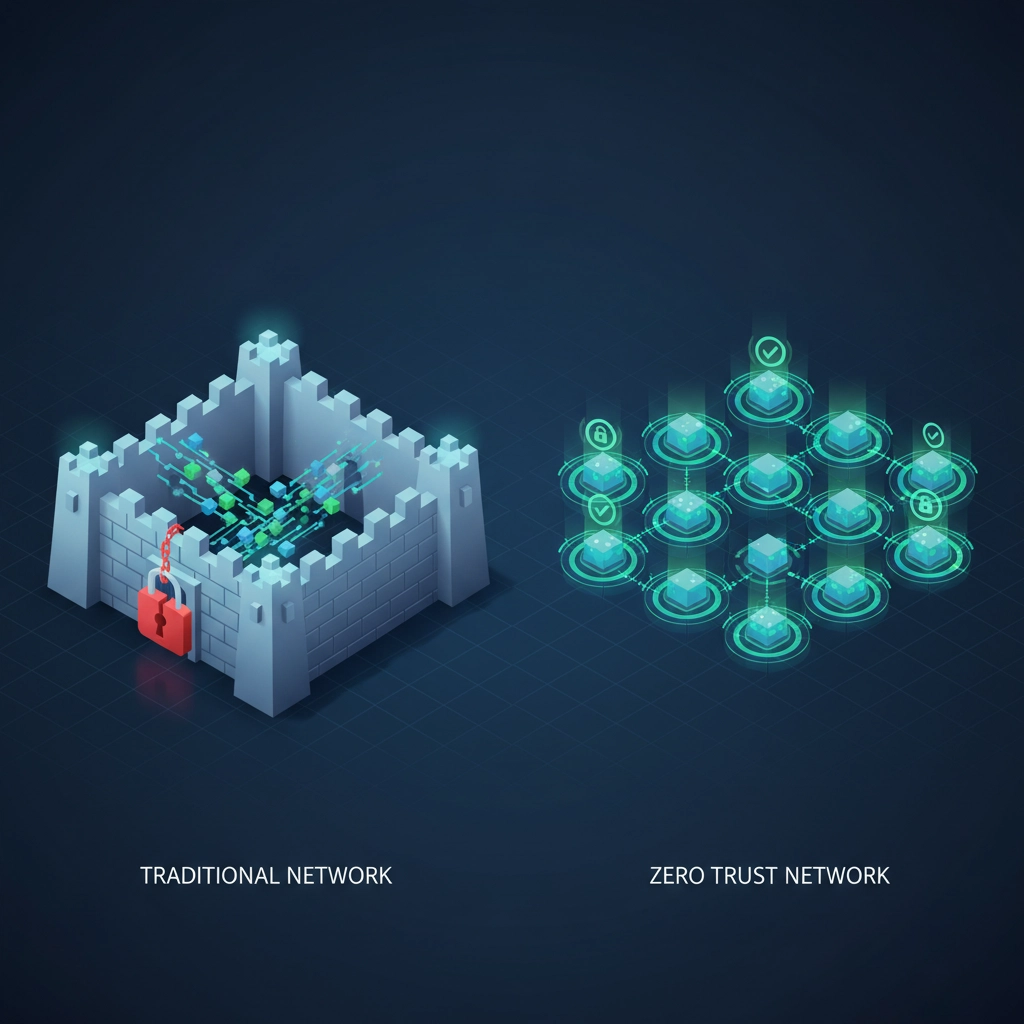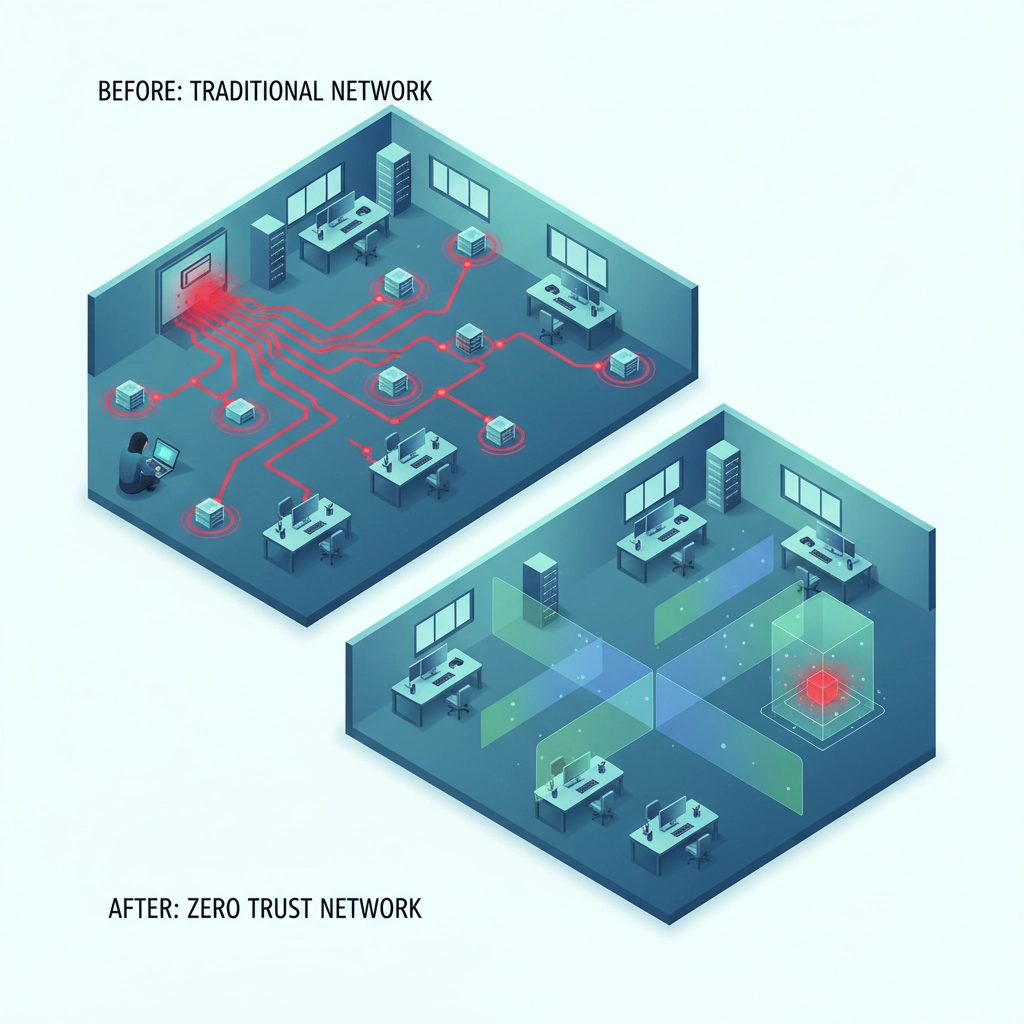Picture this: You're running a business, and someone asks you to choose between two security systems for your office building. The first system has an amazing front door with multiple locks, cameras, and a security guard, but once someone gets past that door, they can walk anywhere in the building freely. The second system checks everyone's ID at every single door, elevator, and restricted area throughout the building.
Which one would actually stop a determined intruder from reaching your most valuable assets?
That's exactly the choice you're facing with your network security in 2025. And spoiler alert: most businesses are still using the "amazing front door" approach, wondering why hackers keep walking straight to their data once they get inside.
Traditional Security: The "Castle and Moat" Problem
Traditional network security is like that first building, it's all about building an impenetrable wall around your entire network. Think of it as the castle and moat approach: massive defenses at the perimeter (firewalls, VPNs, antivirus), but once you're inside the castle walls, you can pretty much go anywhere.
Here's how it works in your network:
- Your firewall acts like a fortress wall, blocking threats from the outside
- Employees connect through a VPN (the drawbridge) to get "inside"
- Once authenticated, users get broad access to internal systems
- Internal network traffic moves freely without much scrutiny
The Good Stuff About Traditional Security:
- It's simple to understand and explain to your team
- Lower upfront costs and complexity
- Most IT folks already know how to manage these systems
- Works well for smaller, simple networks with limited remote access
The Not-So-Good Stuff:
- Once hackers breach your perimeter (and they will), they can move laterally through your entire network
- Internal threats, whether malicious employees or compromised accounts, have free reign
- Limited visibility into what's happening inside your network
- Struggles with cloud services, remote work, and mobile devices
- By the time you detect a breach, attackers have often been inside for months

Zero Trust: The "ID Required Everywhere" Approach
Now imagine that second building where everyone needs to show ID and get permission for every single room they want to enter. That's Zero Trust security.
Zero Trust operates on one simple principle: "Never trust, always verify." Whether you're the CEO connecting from the office or an intern logging in from home, the system treats everyone as potentially suspicious until proven otherwise.
Here's how Zero Trust works in your network:
- Every user, device, and application gets verified before accessing any resource
- Networks are divided into small segments (like individual locked rooms)
- Continuous monitoring watches for suspicious behavior
- Access is granted based on the specific task, not general network membership
Why Zero Trust Wins Against Hackers:
- Micro-segmentation: Even if hackers get in, they're trapped in a small section of your network
- Least privilege access: Users only get access to exactly what they need for their job
- Continuous verification: The system constantly checks if behavior seems normal
- Real-time monitoring: Suspicious activity gets flagged immediately
- Works everywhere: Protects office, remote, and cloud environments equally
The Trade-offs:
- More complex to set up initially
- Requires cultural change in how your team thinks about security
- Higher upfront investment in planning and implementation
- Ongoing management of access policies
Head-to-Head: Which Actually Stops Network Infiltration?
Let's get real about what happens when hackers actually get into your network, because they will. The question isn't if, but when: and what happens next.
Traditional Security vs. a Determined Hacker:
- Hacker breaches perimeter through phishing email or vulnerable system
- Gains access to internal network with legitimate user credentials
- Moves laterally through network, accessing file servers, databases, email systems
- Escalates privileges by compromising administrator accounts
- Exfiltrates data or deploys ransomware across entire network
- Average time to detection: 287 days (according to IBM's 2024 Cost of Data Breach Report)
Zero Trust vs. the Same Hacker:
- Hacker breaches initial access point using same methods
- Attempts to move to file server but gets blocked: needs separate authentication
- Tries different systems but micro-segmentation limits access
- Behavioral monitoring flags unusual access patterns within hours
- Automated systems isolate compromised account and affected network segment
- Damage contained to single segment, full breach prevented

Real-World Effectiveness in 2025
Here's what we're seeing in 2025: Traditional security is failing spectacularly against modern attack methods. Hackers aren't trying to break down your front door anymore: they're walking in with stolen employee credentials, compromised partner accounts, or by exploiting cloud service vulnerabilities.
The Numbers Don't Lie:
- 82% of breaches in 2024 involved human error or compromised credentials
- Average cost of a data breach jumped to $4.88 million
- Organizations with Zero Trust saw 51% lower breach costs compared to those without
Modern Attack Scenarios Traditional Security Can't Handle:
- Stolen credentials: Traditional systems can't tell the difference between a real employee and a hacker using stolen passwords
- Insider threats: Malicious employees already have internal access
- Supply chain attacks: Compromise comes through trusted third-party connections
- Cloud service vulnerabilities: Traditional perimeter doesn't extend to cloud applications
- Remote work risks: VPNs create direct tunnels into your network
Zero Trust handles all of these because it doesn't trust anyone or anything by default.
The 2025 Verdict: Zero Trust Wins, But…
If your main goal is stopping hackers from moving through your network, Zero Trust is the clear winner. It's not even close.
However, here's the practical reality for most businesses:
Choose Zero Trust if:
- You handle sensitive customer data, financial information, or intellectual property
- You have remote employees or use cloud services
- You've experienced a security incident before
- You can invest in proper planning and implementation
- Compliance requirements demand strict access controls
Start with Enhanced Traditional Security if:
- Your network is small and simple (fewer than 25 employees)
- Everyone works in a single office location
- Budget constraints require a phased approach
- Your industry has minimal regulatory requirements
But here's the thing: even if you start with traditional security, begin planning your Zero Trust migration now. The threat landscape isn't getting easier.

Your Practical Next Steps
Immediate Actions (This Week):
- Audit who has access to what in your network
- Implement multi-factor authentication on all critical systems
- Start monitoring unusual network traffic patterns
- Identify your most critical data and applications
Short-term Planning (Next 3 Months):
- Segment your network to isolate critical systems
- Deploy endpoint detection and response tools
- Create detailed access policies based on job roles
- Train your team on security best practices
Long-term Strategy (Next Year):
- Plan your Zero Trust architecture migration
- Evaluate Zero Trust platforms that fit your budget
- Gradually implement micro-segmentation
- Move to cloud-based security services
The Bottom Line
Traditional security is like leaving your house keys in the front door lock: it works great until someone walks in, and then they own your entire house. Zero Trust is like having a security system that requires authorization for every single room, every single time.
In 2025's threat landscape, that room-by-room verification is what keeps hackers from turning a small breach into a company-ending catastrophe.
Ready to stop playing security roulette with your business? Let's talk about building a Zero Trust strategy that actually fits your budget and timeline. Contact B&R Computers today for a practical security assessment that shows you exactly where your network is vulnerable and how to fix it without breaking the bank.
Because the best time to implement Zero Trust was yesterday. The second-best time is right now.




































































































